
Tanfield is a former mining village in County Durham, England, near Stanley, and the location of Tanfield Railway, the Causey Arch and Tanfield School.
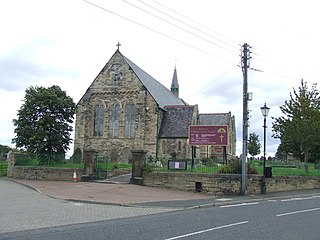
Newbottle is a village in the City of Sunderland in Tyne and Wear, England. The village is situated between Durham 8 miles (13 km) and Sunderland is 5 miles (8.0 km). It was historically a part of County Durham.

Easington Colliery is a town in County Durham, England, known for a history of coal mining. It is situated to the north of Horden, a short distance to the east of Easington Village. The town suffered a significant mining accident on 29 May 1951, when an explosion in the mine resulted in the deaths of 83 men.
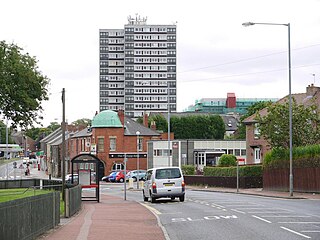
Felling is a town in the Metropolitan Borough of Gateshead in Tyne and Wear, England. Historically part of County Durham, the town became part of the metropolitan borough of Gateshead in 1974. It lies on the B1426 Sunderland Road and the A184 Felling bypass, than 1 mile (1.6 km) east of Gateshead, 1 mile (1.6 km) south east of Newcastle-upon-Tyne and 10 miles north west of the City of Sunderland. In 2011, Felling had a population of 8,908.

Thornley is a village in County Durham, in England. It is situated about 5 miles (9 km) to the east of Durham and 5 miles (7 km) west of Peterlee. Thornley is part of the Sedgefield parliamentary constituency of which Tony Blair was the Member of Parliament from 1983 until 2007.

Great Lumley is a village in County Durham, England. It is situated south east of Chester-le-Street, near Lumley Castle. It has a population of 3,843, reducing to 3,684 at the 2011 census.

Deckham is a residential suburb in the Metropolitan Borough of Gateshead in Tyne and Wear, England. It is bordered by Gateshead town centre to the north, Sheriff Hill to the south, Felling and Carr Hill to the east and Shipcote to the west. It lies on the B1296, the route of the old Great North Road, 1 mile (1.6 km) south of Gateshead town centre, 1.5 miles (2.4 km) south of Newcastle-upon-Tyne and 13 miles (21 km) north of the city of Durham. In 2011, Deckham had a population of 9,938.
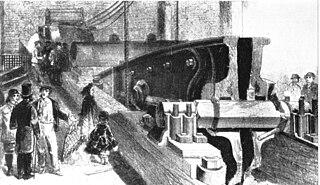
The Hartley Colliery disaster was a coal mining accident in Northumberland, England, that occurred on 16 January 1862 and resulted in the deaths of 204 men and children. The beam of the pit's pumping engine broke and fell down the shaft, trapping the men below. The disaster prompted a change in British law that required all collieries to have at least two independent means of escape.
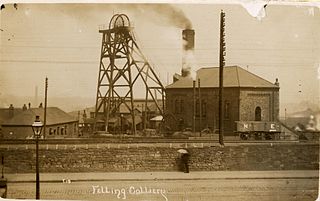
The Felling Colliery in Britain, suffered four disasters in the 19th century, in 1812, 1813, 1821 and 1847. By far the worst of the four was the 1812 disaster which claimed 91 lives on 25 May 1812. The loss of life in the 1812 disaster was one of the motivators for the development of miners' safety lamps such as the Geordie lamp and the Davy lamp.
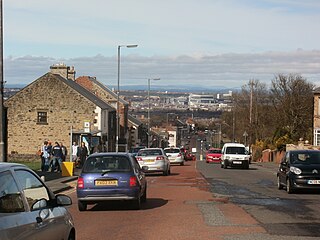
Sheriff Hill is a suburb in the Metropolitan Borough of Gateshead in Tyne and Wear, England. It lies on the B1296 road 2 miles (3.2 km) south of Gateshead, 2.5 miles (4.0 km) south of Newcastle upon Tyne and 12 miles (19 km) north of the historic city of Durham. According to the 2001 UK census it had a population of 5,051.

Low Fell is a suburb of Gateshead situated in the Metropolitan Borough of Gateshead in Tyne and Wear, England. Built predominantly on sandstone, grindstone and clay, it is bordered by Sheriff Hill/Deckham to the east, Saltwell/Bensham to the west, Harlow Green to the south and Shipcote to the north. Low Fell is 3 miles south of Gateshead, 3 miles south of Newcastle upon Tyne and 12 miles north Durham.

Lobley Hill is located in the west of the old County Borough of Gateshead within the Metropolitan Borough of Gateshead in Tyne and Wear, North East England having been previously part of the parish of Whickham.
Matthias Dunn was a British mining engineer and one of the first government inspectors of mines. He was known for encouraging safe practices in mines.

Wharncliffe Woodmoor 1, 2 and 3 colliery was a coal mine that was located at the junction of Laithes Lane and Carlton Road, about 2 miles (3.2 km) north-east of Barnsley, South Yorkshire and a quarter mile east of Staincross and Mapplewell railway station, on the Great Central Railway. The branch line junction was about 200 feet (61 m) from Staincross that connected it to the colliery via a private line. The line finished up between the three main shafts and the coking ovens.

Marley Hill is a former colliery village about six miles to the south west of Gateshead, near the border between Tyne and Wear and County Durham. It has been part of the Metropolitan Borough of Gateshead since 1974. Prior to this it was part of Whickham Urban District. It lies within the Whickham South & Sunniside electoral ward of the Blaydon parliamentary constituency.

Bickershaw Colliery was a coal mine, located at Pennington, in Leigh, then within the historic county boundaries of Lancashire, England.
Gateshead Fell was a district in County Durham, England. It was located on the immediate border of the town of Gateshead, 2.3 miles from the city of Newcastle upon Tyne. Once described as a "dark, spongy moor", Gateshead Fell existed in some form for almost nine hundred years before it was enclosed in 1809 and divided into a number of villages, notably Sheriff Hill, Low Fell and Wrekenton, which were themselves absorbed by the urban expansion of Gateshead and were officially incorporated into the Metropolitan Borough of Gateshead with the passing of the Local Government Act in 1974.

The Sheriff's March was an annual procession at Gateshead Fell, County Durham.
John Hodgson (1779–1845) was an English clergyman and antiquary, known as the county historian of Northumberland.

Bentley Colliery was a coal mine in Bentley, near Doncaster in South Yorkshire, England, that operated between 1906 and 1993. In common with many other mines, it suffered disasters and accidents. The worst Bentley disaster was in 1931 when 45 miners were killed after a gas explosion. The site of the mine has been converted into a woodland.


















